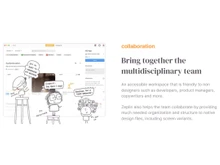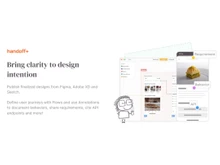As a designer, the selection from collaboration and graphic design tools can either improve or hinder your workflow efficiency. Zeplin and Figma have distinctive features that set them apart from each other. However, evaluating the ideal tool for your team can be a challenging task.
Therefore, this write-up aims to compare each platform, considering different factors such as cost, interface, collaboration features, and integration.
Zeplin vs. Figma: An Overview
Zeplin is a popular design tool used by product designers, developers, and project managers. It offers a comprehensive platform for creating and managing design systems, prototyping, and collaborating with team members. Zeplin provides a wide range of features, including design element libraries, wireframing and prototyping tools, and real-time collaboration capabilities.
Figma is a web-based design tool that allows users to create, collaborate, and share interactive designs. It offers a wide range of features, including vector editing, layers, and real-time collaboration. Figma is popular among developers, designers, and product managers for its ease of use and powerful design capabilities.
Zeplin vs. Figma: Key Differences
The key differences between Zeplin and Figma are as follows:
- Figma is better for design exploration, while Zeplin excels in design handoff and communication.
- Figma is for designers as it allows designing and prototyping without any changes in tools. Zeplin is designed for developers rather than designers, as it provides a straightforward and clean interface that can be easily understood by them.
- Zeplin lacks alert notifications functionality and has a complex user interface.
- Figma requires an internet connection, takes time to upload files, and requires a graphics card for smooth operation.
- Figma and other Figma alternatives are primarily used for prototyping and editing vector graphics, while Zeplin is a collaboration tool for sharing UI/UX work.
- Figma has a browser-based interface and supports multiple operating systems, while Zeplin is available for Windows and Mac.
- Figma offers features like drag and drop, collaboration, and Slack integration, while Zeplin supports files from other software and allows easy organization of artwork/design.
- Figma is a design tool that enables collaboration on layouts, prototypes, and wireframes, while Zeplin is used for managing the handoff process of designs created on other platforms.
- Figma supports a wide range of file formats for import, while Zeplin requires designs to be exported through a plugin.
- The operating platforms of Figma and Zeplin are different, with Figma offering design features and Zeplin providing inspection tools for developers.
Figma vs. Zeplin: In Terms of Features
- Design Exploration: Figma offers features like infinite canvas, templates, libraries, auto-layout, and widgets, making it a flexible and designer-centric tool for creating and iterating on design concepts.
- Design Handoff: Zeplin excels in design handoff by providing developer-friendly formats, asset transfer, and design specification handover. It ensures that the entire product team is aligned and can ship products faster.
- Output Formats: Zeplin only supports SVG (Scalable Vector Graphics) for exporting designs, while Figma offers a wider range of output formats. This flexibility in file types allows for easier transfer of designs to other applications that support different file types.
- Collaboration: Figma offers more robust collaboration features compared to Zeplin. Multiple designers can access the same project and make changes in Figma, while Zeplin only allows the sharing of assets, making it less collaborative.
- File Formats Supported: Zeplin and other Zeplin alternatives allow for downloading assets like icons, while Figma supports exporting entire projects or individual elements in various file formats.
Zeplin vs. Figma: Purpose
Figma is primarily a design and editing tool where designers can explore and iterate on their creative vision. Zeplin, on the other hand, focuses on design handoff and serves as an organized workspace for preserving design intent and facilitating collaboration with developers and non-designers.
Zeplin vs. Figma: User Interface
Zeplin offers a simple and organized interface, making it easy for non-designers to navigate without the need for extensive training or documentation. This encourages wider participation and collaboration within the product team. It provides a platform where designers can design and share their work with developers seamlessly. However, Figma has a more complex interface but offers robust prototyping and collaboration capabilities.
Figma vs. Zeplin: Ease of Use
Figma is initially more complex for designers accustomed to using other design platforms, but it becomes easier to use in the long run. Zeplin's tools are easy to use, but Figma offers more advanced features for managing the handoff process.
Figma and Zeplin: Pricing
Zeplin and Figma offer both free and paid plans. Zeplin offers three pricing plans. These include a Free Plan, Team Plan, and Organization Plan. On the other hand, Figma offers four pricing plans. These are the Free Plan, Professional Plan, Organization Plan, and Enterprise Plan. These pricing plans vary in terms of project limits, style guides, user permissions, version history, and additional features.
Which Is Better, Zeplin or Figma?
In summary, Zeplin and Figma are both powerful design tools with distinct features and purposes. Zeplin excels in design handoff and communication, providing developer-friendly formats and streamlined collaboration with developers. Figma, on the other hand, is a more flexible and designer-centric tool, offering features like infinite canvas, templates, libraries, and robust prototyping capabilities. Both tools support collaboration, but Figma offers more advanced collaboration features, while Zeplin focuses on asset sharing. Apart from that, when it comes to sharing prototypes, Figma allows for interactive sharing, while Zeplin primarily serves as an organized workspace for design intent and collaboration.


 28 Ratings & 28 Reviews
28 Ratings & 28 Reviews
























